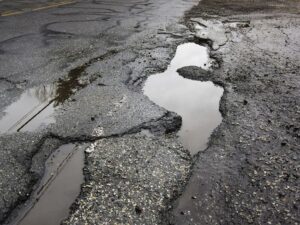A recent study led by Rutgers University of New Brunswick has concluded that well-kept roads, not only save money and energy, but reduce greenhouse gas emissions.
Everyone reaps the benefits of extending pavement’s life by preventative maintenance, Rutgers proves. Greenhouse gas emissions can be reduced by up to 2%, transportation agencies’ can cut spending by 10 – 30%, and drivers’ can save 2 -5% in fuel consumption, tire wear, and vehicle repairs and maintenance. A win for all parties.
“Pavement preservation leads to significant environmental benefits due to the improved surface condition, which results in smooth pavement, saves energy and reduces user costs.” claims Hao Wang, associate professor at Rutgers, Civil and Environmental Engineering department. The greatest overall reduction in carbon dioxide emissions (2%) can be credited to a “thin overlay” wear surface, such as micro surfacing, which decreases the roughness of the road. In fact, Manitoba Transportation’s presentation at the Midwestern Pavement Preservation Conference shows micro surfacing improved IRI (International Roughness Index) ratings by 24% the first year and 12 % over a five year period.
Given the economic climate, Western Canadian Provinces are looking to reduce government spending. Preserving and improving the existing assets tax payers have already paid for makes sense. Micro surfacing is a great way to lower life cycle cost, reduce emissions and provide a higher quality road network for the traveling public. Preventative asphalt maintenance is not only the best way to protect your investment, it’s socially responsible.
Learn more about the benefits of micro surfacing.
Application is Key to a Cold-Mix Fix
 Each changing season brings it’s own set of concerns for your wear-surface. Potholes and cracking that crop up in the spring time can be attributed to water seeping into the underground structure. Moisture gets in through cracks or other defects and expand and contract when the temperature fluctuates, creating spaces where asphalt can crumble with the help of traffic. It’s easy to see how the precipitation and repetitive freeze-thaw cycles of the season can exacerbate seemingly small, preexisting issues, and turning them into big problems.
Each changing season brings it’s own set of concerns for your wear-surface. Potholes and cracking that crop up in the spring time can be attributed to water seeping into the underground structure. Moisture gets in through cracks or other defects and expand and contract when the temperature fluctuates, creating spaces where asphalt can crumble with the help of traffic. It’s easy to see how the precipitation and repetitive freeze-thaw cycles of the season can exacerbate seemingly small, preexisting issues, and turning them into big problems.
A common misconception is that for an asphalt repair to be permanent, it requires a hot-mix fix. When in reality, a high quality cold-mix that has been properly applied can be a long-term repair, saving money, time, and prolonging the life of the existing surface thus delaying the need for an expensive hot-mix undertaking. The key phrase here is “properly applied”.
If the application is poor, the quality of product being used is irrelevant. Taking the time to properly compact the cold-mix you are using, regardless of it’s quality, is how you will get the best results. Rightfully, you can expect more from commercial-grade product, but even the best product, improperly applied, is a waste of resources.

